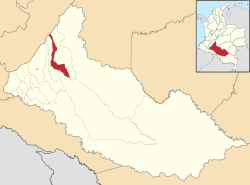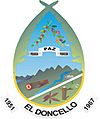El Doncello facts for kids
Quick facts for kids
El Doncello
|
|||
|---|---|---|---|
|
Municipality and town
|
|||
 |
|||
|
|||

Location of the municipality and town of El Doncello in the Caquetá Department of Colombia.
|
|||
| Country | |||
| Department | Caquetá Department | ||
| Population
(Census 2018)
|
|||
| • Total | 17,775 | ||
| Time zone | UTC-5 (Colombia Standard Time) | ||
El Doncello is a town and a municipality in Colombia. It's located in the Caquetá Department, nestled at the foot of the Eastern Mountains.
El Doncello is famous for being Colombia's top rubber producer. More than 200 hectares of land here are used to grow rubber trees. It's also a busy trading hub in Caquetá. Farmers here work hard to make the most of the rich land.
Contents
History of El Doncello
El Doncello has a cool name and a unique history tied to the jungle. It began when a settler named Jorge Abel Molina and a Huitoto Indigenous woman named Maria built their home and farm together.
Other settlers soon joined them, building more homes and even a school. This small community grew into the town we know today.
Founding the Town
The founders of El Doncello, besides Jorge Abel Molina, were Daniel Claros, Ricardo España, Jesús Collazos, Rufino Quichoya, Calixto Morales, and Carlos Polanco. As El Doncello grew, other small villages like Rio Negro, Puerto Manrique, and Maguaré also started to develop.
The area of Maguaré was especially helped by the Caja Agraria, a bank that supported new settlements in 1950. The town is surrounded by rivers and streams like the Doncello and Anayá rivers. There's also the beautiful Rio Negro Lagoon, which tourists love to visit.
Settlers moving into Northern Caquetá needed a place to rest and get supplies between Florencia and Puerto Rico. The best land for this was owned by Jorge Abel Molina and Rufino Quichoya.
On March 20, 1951, a group of people decided to build a hamlet (a small village). Jorge Abel Molina generously donated land for a town square and a school.
First Leaders
The first group that helped organize the town included:
- President: Mariano García
- Vice President: Rufino Quichoya
- Treasurer: Jorge Abel Molina
- Fiscal: Custodio Gómez
- Secretary: Ricardo García
Consolata Missionary Juan Demichelis was a pioneer in the municipality. Another missionary, Juan Bautista Migani, helped baptize the town on July 14, 1951. He also helped get the first teachers, Eva Cedeño de Orozco and Margarita Arboleda de Hoyos, who started teaching in February 1952. The first school and church were in a small building where Founders Park is today. The town was named San Juan, after its patron saint (San Juan Bautista), and El Doncello, after a local tree.
Growth and Development
On April 12, 1952, El Doncello became a Police Inspectorate, a type of local government area. Later, on October 9, 1956, it was upgraded to a Corregimiento, which is a larger administrative division.
Around 1959, a part of El Doncello called Maguaré became a colonization center. This project helped expand farming land by over 25,000 hectares and brought about 3,000 new settlers from different parts of Colombia.
In 1961, the project was taken over by Incora, a new agency created to manage these types of programs. The main road reached El Doncello in 1959, making travel easier. The telegraph arrived in 1960, connecting the town to the outside world.
Also in 1960, the first boys' school, named Jorge Abel Molina, was built. Two years later, the Immaculate Heart of Mary School for girls opened, offering secondary education by 1966. In 1967, the Minister of Government, Misael Pastrana Borrero, visited and promised to build a new neighborhood. This promise came true in 1968 with the construction of 20 houses, creating the El Jardín neighborhood.
As El Doncello grew, more roads, schools, and health centers were built. Transportation and other public services also improved. Because of this fast growth, the people and leaders of El Doncello felt it was time for the town to become a municipality. On October 12, 1967, El Doncello officially became a municipality. Its first mayor was José Ignacio Rojas.
Modern services continued to arrive. Electricity from the national system was installed in 1986. This was thanks to the hard work of local business owners and Captain Guillermo Espitia, who also helped create the Volunteer Fire Department. Direct phone service arrived in 1992, making communication even easier.
Geography of El Doncello
El Doncello is made up of many small rural areas called Veredas. It's located where the Eastern Mountain Range meets the plains. The town center is about 480 meters (1,575 feet) above sea level, with an average temperature of 26°C (79°F).
The soil in El Doncello is typical of the Amazon region. It's often acidic and not very fertile.
Like many areas in the Amazon foothills, El Doncello faces challenges. There's a problem with too many trees being cut down. This, along with the growing of illegal crops, affects the environment and the town's situation.
Most of the land is used for raising cattle, which doesn't always make the best use of the soil. This means there isn't a strong economic base that connects farming areas with the town. Also, because cattle farming is so common, there aren't many factories or manufacturing jobs. The town has grown quickly, but sometimes without enough proper buildings and services.
Nearby Towns
Here are some distances to other towns from El Doncello:
- Florencia 69 km
- Albania 145 km
- Belén de los Andaquies 115 km
- Cartagena del Chairá 82 km
- Curillo 164 km
- El Paujil 14 km
- La Montañita 37km
- Milán 85 km
- Morelia 93 km
- Puerto Rico 35 km
- San Vicente del Caguán 93 km
- San José del Fragua 133 km
- Solano
- Solita 107 km
- Valparaíso 48 km
El Doncello does not have major river transportation.
Climate
| Climate data for El Doncello (Maguare), elevation 270 m (890 ft), (1981–2010) | |||||||||||||
|---|---|---|---|---|---|---|---|---|---|---|---|---|---|
| Month | Jan | Feb | Mar | Apr | May | Jun | Jul | Aug | Sep | Oct | Nov | Dec | Year |
| Mean daily maximum °C (°F) | 32.7 (90.9) |
32.3 (90.1) |
31.2 (88.2) |
30.5 (86.9) |
29.8 (85.6) |
28.9 (84.0) |
28.7 (83.7) |
29.9 (85.8) |
30.8 (87.4) |
31.0 (87.8) |
30.8 (87.4) |
31.8 (89.2) |
30.7 (87.3) |
| Daily mean °C (°F) | 26.8 (80.2) |
26.5 (79.7) |
25.9 (78.6) |
25.4 (77.7) |
25.1 (77.2) |
24.4 (75.9) |
24.2 (75.6) |
24.8 (76.6) |
25.4 (77.7) |
25.6 (78.1) |
25.8 (78.4) |
26.2 (79.2) |
25.5 (77.9) |
| Mean daily minimum °C (°F) | 20.8 (69.4) |
21.2 (70.2) |
21.5 (70.7) |
21.6 (70.9) |
21.5 (70.7) |
20.8 (69.4) |
20.3 (68.5) |
20.4 (68.7) |
20.7 (69.3) |
21.1 (70.0) |
21.4 (70.5) |
21.0 (69.8) |
21.0 (69.8) |
| Average precipitation mm (inches) | 76.4 (3.01) |
144.1 (5.67) |
292.2 (11.50) |
417.2 (16.43) |
370.9 (14.60) |
348.3 (13.71) |
303.5 (11.95) |
210.5 (8.29) |
234.8 (9.24) |
286.8 (11.29) |
213.5 (8.41) |
95.4 (3.76) |
2,942.3 (115.84) |
| Average precipitation days | 8 | 12 | 18 | 23 | 24 | 24 | 22 | 20 | 19 | 19 | 17 | 10 | 209 |
| Average relative humidity (%) | 75 | 78 | 83 | 86 | 86 | 87 | 86 | 84 | 83 | 83 | 83 | 80 | 83 |
| Mean monthly sunshine hours | 186.0 | 132.7 | 102.3 | 96.0 | 105.4 | 93.0 | 102.3 | 130.2 | 147.0 | 148.8 | 150.0 | 182.9 | 1,576.6 |
| Mean daily sunshine hours | 6.0 | 4.7 | 3.3 | 3.2 | 3.4 | 3.1 | 3.3 | 4.2 | 4.9 | 4.8 | 5.0 | 5.9 | 4.3 |
| Source: Instituto de Hidrologia Meteorologia y Estudios Ambientales | |||||||||||||
Culture and Celebrations
El Doncello has several fun festivals and events throughout the year.
Festivities
- Folkloric Festival of Caquetá: A celebration of local traditions and culture.
- San Pedrinas Festivities: Lively parties honoring Saint Peter.
- Departmental Rubber Festival: This festival celebrates the town's main product, rubber.
- Commercial and Cattle Fair: A big event for trading goods and showing off livestock.
- Old Year's Parade: A special parade to say goodbye to the old year.
- Fairs and Festivals: Other local gatherings and celebrations.
- Religious Events:
- Holy Week: Important religious ceremonies during Easter week.
See also
 In Spanish: El Doncello para niños
In Spanish: El Doncello para niños




